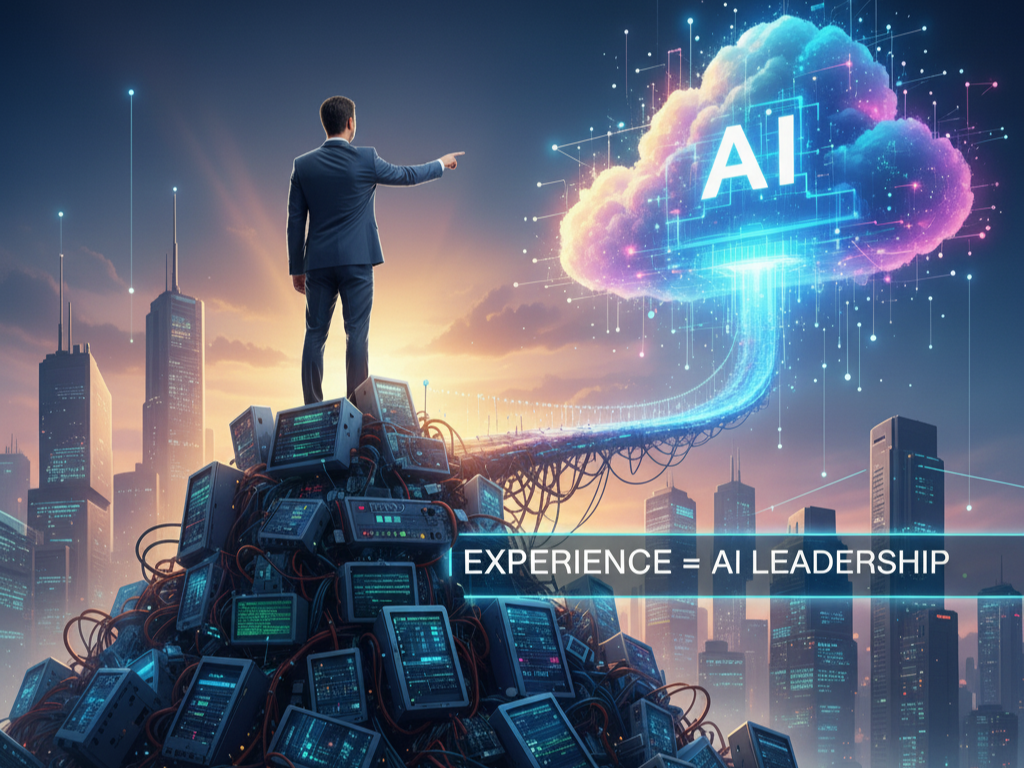Let’s just speak frankly for a moment. If you’re a seasoned IT professional with a decade or more of experience, you’re likely feeling that persistent ache of stagnation. You’ve earned your stripes, but the next big move feels impossible and the fear of being replaced by AI is absolutely real. Stop seeing your 10 to 15 years of experience as a liability. It is your superpower. The reality is, the next wave of High-Paying Jobs in AI isn’t for new grads; it’s specifically for leaders like you who deeply understand how the business actually runs.
This guide is here to show you how to leverage that massive, valuable history. You can execute a strategic pivot into roles where your deep experience, whether in management, security or domain knowledge, commands the absolute highest premium in this new economy. Remember, you’re not starting over; you’re pivoting straight into leadership. We’ll cut through the jargon, map out the most lucrative and realistic paths and show you the exact strategies you need to master to secure your premium salary.
Why Your 15 Years of IT Experience is the Gold Standard for High-Paying Jobs in AI

The biggest, most demoralizing mistake experienced pros make is thinking they need to hit the reset button and go back to being a “Junior Data Scientist.” That’s completely wrong. You are not starting from scratch; you are pivoting to Strategic AI Leadership Roles.
The Unmet Demand for AI Leaders
When a company hires a fresh-out-of-school ML Engineer, they get great code. When they hire you, they get a pro who knows how to scale that code, secure the data pipeline, manage the budget, communicate risk to the board and successfully integrate the whole solution into a messy legacy enterprise system. That, my friend, is exactly what drives the salaries for High-Paying Jobs in AI at the senior level. Companies aren’t short on models; they are desperate for leaders who can make those models profitable and production-ready.
Your Domain Expertise: The Irreplaceable Asset
Did you grind out your career in FinTech, Healthcare or Supply Chain logistics? Fantastic. That’s ten years of messy, nuanced, real-world knowledge that an algorithm knows nothing about. The future belongs to the AI Translator, the person who can combine a little technical know-how with their deep, proven industry wisdom. This powerful fusion of IT history and AI strategy is what unlocks the most lucrative transition roles. According to a recent report by McKinsey on the future of global employment, the scarcity of high-level AI expertise combined with industry domain knowledge is the single biggest factor driving wage inflation.
The Strategic Pivot: High-Paying Jobs in AI for Experienced Professionals
You need to skip the entry-level noise. Your experience immediately qualifies you for these high-impact, high-compensation roles where strategic oversight is worth far more than writing Python loops.
1. AI Product Manager: The Business Bridge
- Your Leverage: You already live and breathe the product lifecycle, stakeholder management and budget realities. You won’t build the model; you’ll define why it should be built, what problem it solves and how to measure its massive success.
- The Transition: Focus aggressively on AI product strategy and Generative AI applications. This role prioritizes your past management wins.
2. MLOps Engineer/Architect: The Reliability Guru
- Your Leverage: If you spent years in DevOps, Cloud Architecture (AWS, Azure, GCP) or Enterprise IT Security, this is your natural home. MLOps is the art of deploying, monitoring and maintaining AI models reliably, a complex engineering challenge that screams for your veteran infrastructure experience.
- The Transition: Leverage your existing cloud certifications. You’re just shifting your focus to specialized ML flow tools (like MLflow) and containerization (Kubernetes, Docker).
3. AI Solutions Architect: The Systems Designer
- Your Leverage: You understand enterprise complexity. You design the whole blueprint: “This is how we securely pull the data from the legacy system, clean it in Spark, train it in PyTorch on the cloud and safely serve it via a secured API.”
- The Transition: Pivot your existing expertise toward AI platform integration and security protocols for data pipelines. This role is a perfect match for senior IT architects.
Beyond finance and logistics, remember that many AI leadership roles are emerging in specialized sectors. To see how one major vertical is evolving, explore the critical role of AI in transforming education with technology.
These aren’t just great High-Paying Jobs in AI; they are careers where your age and wisdom are seen as a powerful competitive advantage.
The Practical Upskilling Roadmap: AI Skills for Indian Youth (and the Wise)

Yes, you have to learn new things, but thankfully, your core programming and IT foundations are strong. You need targeted, laser-focused upskilling to fill specific, high-leverage gaps.
1. The Targeted Technical Stack
- Embrace Python: You probably master Java or C#. You need to become proficient with Python, especially the data science ecosystem (Pandas/Scikit-learn) fast. It’s the standard for rapid prototyping.
- Math Refresher is Key: Don’t panic! You don’t need a Ph.D. You need enough math to understand Model Evaluation (is the investment paying off?) and Model Optimization (how do we make it faster and better?). Focus heavily on the application of statistics, not the theoretical proofs.
- Big Data Focus: Your database knowledge is an advantage. Shift your attention to Big Data processing tools like Hadoop and Spark. Modern AI runs on gigantic datasets, so you need to know how to feed the beast.
2. The Power of Executive Certifications
Forget starting an entire Master’s degree. For the 10 to 15 year veteran, specialized, executive-style programs are the smart ROI:
- Executive PGP Programs: Look for Post Graduate Programs in AI/ML offered by reputed institutions (IITs, Great Lakes) or global partners. These programs are specifically designed for working professionals who need business context, not just deep code.
- Cloud AI Certifications: Secure certifications like Azure AI Engineer or AWS Certified ML Specialty. These immediately validate your ability to manage and deploy models at enterprise scale, the exact role your existing experience supports.
This targeted approach to acquiring AI skills for Indian youth (and experienced pros!) saves you time, money and validates skills most relevant to High-Paying Jobs in AI.
Strategies for Adapting to AI in the Workplace
If you’re currently employed, don’t watch from the side-lines. You need to become aggressive about adapting to AI in the workplace. The core philosophy is simple: Master the machine and become ten times more valuable.
Be the AI Strategist, Not the Coder
Immediately start using generative AI (LLMs) for your routine tasks: drafting executive summaries, creating complex documentation or even generating preliminary code drafts. By augmenting your productivity, you free up your valuable time for critical human leadership: difficult decision-making, team management and strategic planning. This is how you stay relevant: you evolve from a manager of people to a director of sophisticated technology.
Leverage Your Enterprise Security Experience
Here’s a huge opportunity. The single biggest fear C-level executives have about AI is governance, bias and security. If your background is in Cyber Security, Compliance or Audit, you are uniquely positioned to transition into an AI Governance Lead or Responsible AI Architect. Your decade plus understanding of regulatory risk (like the Digital Personal Data Protection Act) is a precious, high-value asset that no new graduate can compete with. Adapting to AI in the workplace means selling your existing risk management skills as a core AI competency.
Overcoming the Fear and Landing Your Future Careers in India

We need to address the emotional elephant in the room. After 15 years, the thought of “starting over” feels paralyzing. But please, remember this is a pivot, not a start. Your biggest challenge is often mindset, not skill.
Reframe Your Résumé and Network
- Ditch the History: Your résumé shouldn’t be a 15-year chronological timeline. It needs to be a forward-looking document focused only on high-impact projects that align with AI. Focus on measurable outcomes: “Architected a scalable, secure data pipeline that processed 10M records,” not “Managed the legacy system.”
- Find Your Tribe: Join executive-level AI groups and forums. Don’t waste time networking with fresh grads; network with CTOs and VPs who are desperate for experienced leaders to solve their scaling challenges. Your connections are critical for unlocking the best future careers in India.
- Start Your Internal Project: The safest path is to propose an AI proof-of-concept within your current company. Use your current domain knowledge to solve a high-value, niche problem. This internal win is the perfect, low-risk way to transition your role and prove you’re ready for the High-Paying Jobs in AI sector.
The opportunities for future careers in India are reserved for those who are brave enough to take this strategic leap and realize that their decades of experience were just preparation for this monumental moment.
Frequently Asked Questions (FAQs)
What are the highest-paying roles considered High-Paying Jobs in AI for IT professionals with 10+ years of experience in India?
The highest-paying roles are often strategic and architecture-focused, combining deep domain knowledge with AI expertise. Roles commanding salaries up to ₹40-60 LPA for experienced professionals (10+ years) include:
- AI Solutions Architect / Cloud Architect (AI-focused): Designs the infrastructure for large-scale AI deployment.
- Head of AI / Director of Data Science: Focuses on setting organizational strategy and leading large teams.
- AI Product Manager: Bridging the gap between business needs and technical AI development.
- MLOps Lead: Ensuring the robust and scalable deployment of Machine Learning models in production.
What is the realistic salary jump for a 15-year IT veteran pivoting to AI?
The compensation potential is huge because you’re entering the strategic leadership bracket. A professional moving from a conventional IT Manager role (say, ₹25 to ₹35 LPA) to an AI Solutions Architect or AI Product Manager role often sees a 30% to 50% jump, placing them easily in the ₹40 to ₹60 LPA range, firmly securing a spot in the High-Paying Jobs in AI segment.
Is my age a liability in the AI field?
Absolutely not. For the senior, strategic roles (Architect, Product Manager, Consultant), your age signifies wisdom, domain context, business navigation skills and reliability, all traits entry-level candidates simply lack. Your 15 years of consistent project delivery is the single best selling point you have.
Do I need to quit my job to learn the new AI skills for Indian youth?
No way. You must use part-time, online, executive-focused PGP or certification programs. These are designed to be completed while working. Quitting your job means giving up your most valuable asset: your continuous enterprise experience.
Which is the better specialization for me: Data Scientist or AI Product Manager?
If you thrive on pure math and writing complex coding, go for Data Scientist. If you love strategy, managing clients, defining requirements and ensuring business ROI (which aligns with your experience), AI Product Manager or Solutions Architect is the superior, high-leverage pivot.
What’s the fastest way to get practical experience?
Two main ways: 1) Internal Projects: Start an AI project at your current job using your existing domain knowledge. 2) Consulting/Advising: Use your experience to consult on the architecture or strategy of a start-up’s AI stack, even if you are not doing the core coding. This proves you can deliver High-Paying Jobs in AI outcomes.
Final Thoughts and Call to Action
Stop feeling stagnant. Stop letting fear guide your career. Your decades in the IT trenches have given you the deep perspective, the domain mastery and the grit needed to lead this AI revolution. The path to High-Paying Jobs in AI is not about starting over; it’s a strategic pivot where your accumulated wisdom is your greatest, most valuable asset. The future careers in India are waiting for leadership, not labor. It’s time to stop managing legacy IT and start architecting the intelligent enterprise
